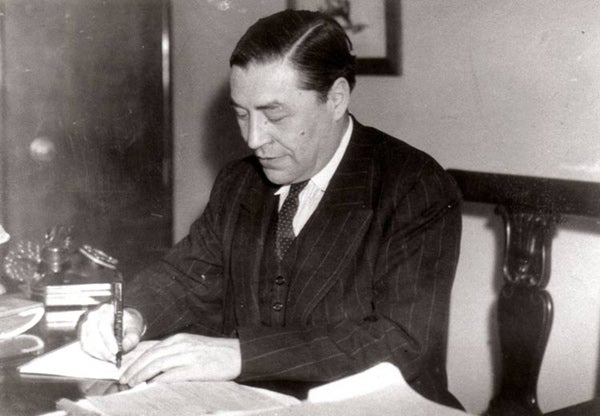|
December 18, 2014
Stanford scholar spotlights Catalan journalist
A ban on the Catalan language left the voluminous works of Spanish writer and journalist Josep Pla unrecognized for decades, but Stanford Professor Joan Ramon Resina is resurrecting Pla's reputation. By Cuauhtémoc García-García

Spanish journalist Josep Pla works at the office of the weekly "Destino" in 1942. Stanford Professor Joan Ramon Resina is working to bring Pla's works out of obscurity. (Fundació Josep Pla, Vergès Collection)
At the dawn of the 20th century, Spain was politically unstable. During subsequent dictatorships spanning the 1920s to the 1970s, the public use of Catalan, the language of Catalonia, a culturally distinct region in northeastern Spain, was prohibited.
In that same period, Josep Pla was a reporter and news correspondent for various Spanish and Catalan newspapers. In addition to penning local lifestyle stories, Pla filed numerous first-hand accounts of pivotal 20th- century events, from Mussolini's march on Rome and the fall of the Spanish monarchy to the early days of the Soviet Union.
Over his lifetime, Pla published nearly 30,000 pages, creating, among other things, a written account of Catalan life and culture that Stanford Professor Joan Ramon Resina calls "a road map to the history of the 20th century in the Iberian Peninsula and beyond."
A creative writer at heart, Pla crafted vivid and astute descriptions about society, including biographies, travel books, diaries, letters and chronicles.
But because Pla published most of his books in Catalan during a time when the Spanish government limited publication in the language, his works have been largely unavailable in other languages and, as a result, underappreciated.
Resina, a professor of Iberian and Latin American cultures and comparative literature at Stanford, is helping to shed light on Pla's literary achievements.
A fellow at the Stanford Humanities Center, Resina is completing a book about some of Pla's most significant contributions, including the political implications of his work and the way he wrote about physical landscape, which explores how humans establish their sense of place and develop their sensory potential.
Resina suggested that Pla belongs in the literary canon alongside other prominent period writers – Stefan Zweig, Joseph Roth, Karl Krauss, Albert Camus and Truman Capote.
Pla's works, Resina explained, contain "valuable information on a plethora of figures from different cultures and walks of life and, taken together, constitute a remarkable example of someone who, in his own words, was hostage to 'the devilish mania of writing.'"
While most of Pla's writings are only available in Catalan or Spanish, his most famous book, El Quadern Gris, has just been translated into English, according to Resina.
The language of the streets
As a journalist, Pla found himself tethered to the chore of writing daily cultural or political chronicles for local newspapers. However, Resina pointed out, Pla's literary ambitions compelled him to write with an "extraordinary degree of insight and subtlety," transforming his articles from mere reports into "devices for communicating his worldview to readers."
Reflecting the Catalan society of his time, Pla wrote about the peasants, fishermen, shopkeepers, the bourgeoisie and the employers. Resina said that he "did not simply take the language mechanically from the streets, but took the language of the streets to an unprecedented suppleness and acuity."
"The young Pla had the courage to break away from the dominant ideology that mandated writing in a highly cultured language. He began his literary career writing in a very accessible language that reflects his need to produce journalistic work," he said.
This writing style gave Pla an ample readership in Catalonia, one that found his writing not only understandable, but also conversational and familiar.
"He created a modern equivalent to Balzac's La Comédie Humaine, where the French novelist Balzac tries to produce a picture of France's Second Empire," Resina said.
Resina further suggested that Pla "did the same thing for Catalonia between the years before the Spanish Civil War and the end of Francoism." Wrote Pla: " The first duty of a writer is to observe, narrate, express the epoch in which he or she is located."
Cultivating a literary style
Resina pointed out that the stylistic attribute that separates Pla from other writers is his obsession with description. This was reflected in his continuous preoccupation with finding just the right adjective for every object he wrote about. Pla noted, "I have tried to add adjectives behind nouns, and that's what I have done all my life."
However, Resina said, Pla was aware of Catalan's limitations as a language "that did not yet have sufficient tradition in literary writing and therefore had not evolved enough to allow writers to say something with the degree of flexibility and facility that one could find, for instance, in French or Italian."
As Resina noted, although Pla continuously grappled with abstract concepts such as time and space in his works, he distinguished himself by addressing them in an accessible, non-theoretical way. "He thought that abstraction is cheating, that it is a fabrication of a class of individuals called intellectuals," Resina said. "Pla created an underground philosophy of life that is quite consistent across his literary oeuvre – one that has the appearance of great simplicity, but which is in fact of extraordinary complexity."
For instance, in his various personal diaries, Pla reflected about the nature of time, grappling with questions such as, "How do we operate? How does it affect life? How does it shape any potential experience?"
According to Resina, Pla considered himself a realist and thought the main duty of a writer was to "accept the huge challenge of describing the world as it actually appears, rather than resorting to abstract concepts."
Cuauhtémoc García-García is a doctoral candidate in the Department of Iberian and Latin American Cultures at Stanford. For more news about the humanities at Stanford, visit the Human Experience.
-30-
|